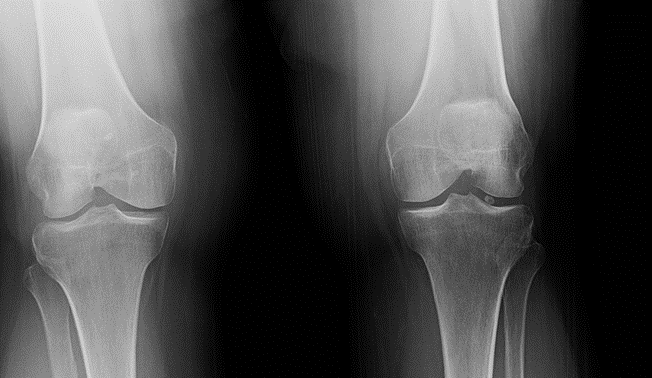Non-Operative Treatment Alternatives for Loose Bodies in the Knee
What are loose bodies in the knee joint?
A loose body is a small fragment of cartilage or bone that breaks off in the knee joint. This can be a result of trauma or degeneration. Loose bodies can vary in size and location, and sometimes there is more than one. They are classified as unstable (floating in the synovial fluid) or stable (trapped within the joint). Common causes of loose bodies include traumatic injury to the knee degenerative joint disease (osteoarthritis, rheumatoid arthritis), and other inflammatory diseases.

What are symptoms of loose bodies in the knee joint?
If symptomatic, one may experience knee pain, a grating sound with movement (Crepitus), decreased joint range of motion, limited mobility & difficulty walking, sensation of locking or catching in the knee, or feeling something moving within the knee. Sometimes the knee may swell.
What are complications of loose bodies in the knee joint?
If symptomatic and left untreated, loose bodies may damage the cartilage further resulting in further degeneration (osteoarthritis).
How are loose bodies in the knee joint diagnosed?
Loose bodies in the knee joint may get may be diagnosed via plain radiographs (x-rays) taken at the doctor’s office. To get a more detailed look, a CT or MRI may be performed, with or without dye injected to better visualize the loose body if needed (an x-ray of the knee after a dye has been injected is called an Arthrography). Sometimes these are seen incidentally during a knee arthroscopy (surgical scope of the knee).
How are loose bodies in the knee joint treated?
If there is a loose body with no significant arthritis, sometimes conservative management is trialed to restore motion and decrease pain, or sometimes a knee arthroscopy is performed to surgically remove the cartilage/bone fragment. Symptomatic loose bodies due to degeneration are managed just as knee osteoarthritis (OA) is managed. Knee OA is typically managed conservatively until progressive symptoms prompt the patient to seek a knee replacement. There are many conservative treatment options that one can try to either delay or prevent need for a knee replacement. Some conservative options include weight loss, activity modification, physical therapy, bracing, supplements and oral medications, and injections. Unfortunately, there are no known non-surgical cures to eliminate loose bodies in the knee or reverse osteoarthritis, but many treatment options can help reduce symptoms of pain, stiffness, or swelling, and there are potentially some treatments that may slow OA progression. If a patient stops responding to conservative interventions, then a total knee replacement is considered.
-
Weight loss/Diet – Every extra pound is felt as 4 pounds through the knee. Therefore, weight loss can reduce excess stress through the joint. Additionally, weight loss of over 10% of staring body weight has been shown to improve pain, function and quality of life. Weight loss may also decrease inflammation and slow rate of OA progression. Weight loss is best achieved through diet modifications and low-impact aerobic exercise.
-
Physical therapy – Supervised exercise with a physical therapist combined with a home exercise program have been found effective in decreasing pain and improving function in the knee. The exercises should be maintained after PT has ended or else benefits will be lost.
-
Supplements – There is conflicting evidence regarding the benefit of supplements for knee osteoarthritis. Curcumin*, a component of turmeric, has anti-inflammatory properties and may reduce pain, however studies are limited. Collagen (UC-II) in one study improved pain and function in knee OA. Methylsuflonylmethane (MSM) may improve pain and function in knee OA, although this finding is based on limited studies. While glucosamine chondroitin* has been studied extensively, studies suggest that if there is any benefit it may be very small.
*These supplements may interact with blood thinning medications
-
Oral medications – Over the counter medications such as acetaminophen (Tylenol) or non-steroidal anti-inflammatories (NSAIDs) are frequently used by patients for knee pain before they see a physician. While these are typically effective to lessen symptoms, they have many side effects so caution should be taken if using consistently. There are prescription NSAIDs that may last longer to reduce frequency of medications.
-
Injections – Traditionally, corticosteroids have been the main injection used to reduce inflammation and pain from knee OA. While they may be helpful for symptoms, corticosteroids may potentially harm the cartilage if performed too frequently. Benefit from steroid injections typically last about 3 months. Hyaluronic acid (HA) injections have had mixed evidence in the literature. HA is found in the knee joint cartilage and fluid, and it has been found to break down in knee OA. Injection of HA may lubricate and increase the HA within the joint. These typically require a series of 3 injections and need insurance approval. If these injections offer benefit, it typically lasts around 6 months. Regenerative options can be considered such as platelet rich plasma (PRP) in which the injection’s goal is to stimulate the body’s natural “healing” response to reduce pain, stiffness and improve function in knee OA. These injections typically take several weeks to notice benefit, but effects may last 9-12 months. PRP injections are still are not covered by most insurances. All of these injections are studied in mild to moderate knee OA. When arthritis is more advanced, these injections may not work or have less efficacy or duration of benefit.





